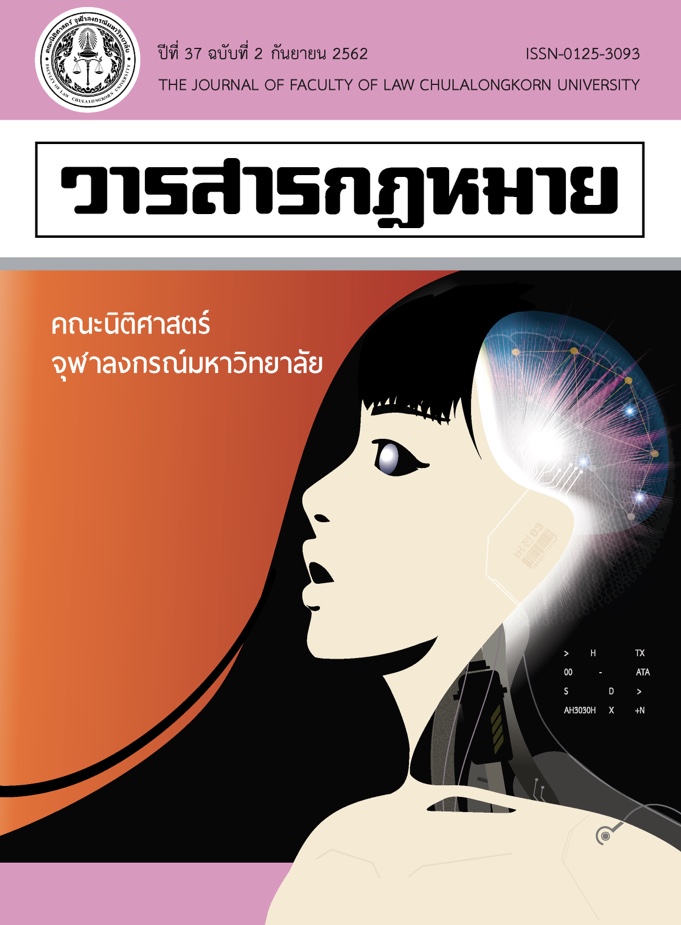ความรับผิดทางแพ่งของผู้นำเข้าเครื่องปรับจังหวะการเต้นของหัวใจและเครื่องกระตุกหัวใจ ตามกฎหมายความรับผิดในผลิตภัณฑ์ของประเทศสหรัฐอเมริกา สหภาพยุโรป และประเทศไทย
Main Article Content
บทคัดย่อ
บทความนี้มีวัตถุประสงค์ในการวิเคราะห์ความรับผิดทางแพ่งของผู้นำเข้าสินค้าประเภทเครื่องปรับจังหวะการเต้นของหัวใจ (pacemaker) และเครื่องกระตุกหัวใจ (defibrillator) ในประเทศไทย เครื่องมือดังกล่าวอาจมีความชำรุดบกพร่อง เป็นต้นว่าสายสื่อสัญญาณไฟฟ้าบกพร่องทำให้หัวใจเต้นผิดปกติอย่างรุนแรงและนำไปสู่การเสียชีวิตโดยกะทันหันได้ แบตเตอร์รี่ของเครื่องมีอายุการใช้งานสั้นกว่าที่คาดหวัง หรือสวิตช์แม่เหล็กปิดเปิดเครื่องชำรุดบกพร่องจึงจำเป็นที่แพทย์ต้องผ่าตัดเพื่อนำเครื่องที่ใส่อยู่ในตัวผู้ป่วยออกและนำเครื่องใหม่ใส่เข้าไปแทน ในบทความนี้ ผู้เขียนได้วิเคราะห์ความรับผิดทางแพ่งของผู้ผลิตเครื่องปรับจังหวะการเต้นของหัวใจ และเครื่องกระตุกหัวใจในประเทศสหรัฐอเมริกาตามกฎหมายละเมิด กฎหมายความรับผิดในผลิตภัณฑ์ และกฎหมายเครื่องมือแพทย์ เพราะประเทศสหรัฐอเมริกาเป็นประเทศที่มีประสบการณ์ยาวนานที่สุดและมีคดีฟ้องร้องเกี่ยวกับความชำรุดบกพร่องของเครื่องปรับจังหวะการเต้นของหัวใจและเครื่องกระตุกหัวใจจำนวนมากที่สุด ผู้เขียนพบว่าประเทศสหรัฐอเมริกามีระบบการตรวจสอบเครื่องมือแพทย์ที่เข้มงวดมากโดยคณะกรรมการอาหารและยา ทำให้ผู้ผลิตเครื่องมือแพทย์ดังกล่าวทั้งสองชนิดไม่ต้องรับผิดโดยเคร่งครัด นอกจากนี้บทความได้ศึกษาความรับผิดทางแพ่งของผู้นำเข้าสินค้าเครื่องมือแพทย์ทั้งสองชนิดดังกล่าวตามกฎหมายความรับผิดในผลิตภัณฑ์ และกฎหมายเครื่องมือแพทย์ของประเทศเยอรมนี อีกทั้งกฎหมายความรับผิดในผลิตภัณฑ์ของสหภาพยุโรปในฐานะที่ประเทศเยอรมนีเป็นรัฐสมาชิก ในกรณีที่สินค้าที่นำเข้านั้นมีแบตเตอร์รี่ที่มีอายุการใช้งานสั้นกว่าที่คาดหวัง หรือสวิตซ์แม่เหล็กปิดเปิดเครื่องชำรุดบกพร่องจนทำให้แพทย์ต้องผ่าตัดเอาเครื่องที่ใส่อยู่ในตัวผู้ป่วยออกและใส่เครื่องมือใหม่เข้าไปแทน ท้ายที่สุด บทความนี้ได้วิเคราะห์กฎหมายไทยที่เกี่ยวข้อง ไม่ว่าจะเป็นกฎหมายลักษณะละเมิด กฎหมายความรับผิดในผลิตภัณฑ์ และพระราชบัญญัติเครื่องมือแพทย์ พ.ศ. 2551 จากการศึกษาวิเคราะห์กฎหมายและคำพิพากษาของศาลในประเทศสหรัฐอเมริกาและประเทศเยอรมนี ผู้เขียนเสนอว่าเพื่อให้การคุ้มครองผู้ป่วยโรคหัวใจที่เคราะห์ร้ายจากอุบัติเหตุการชำรุดบกพร่องของเครื่องมือแพทย์ทั้งสองได้รับการเยียวยาที่เพียงพอและเป็นธรรมในบริบทของประเทศไทย ผู้นำเข้าควรต้องรับผิดอย่างเคร่งครัดต่อผู้ป่วยโรคหัวใจที่ได้รับความเสียหายจากความชำรุดบกพร่องของตัวเครื่อง อุปกรณ์ภายในและอุปกรณ์ที่เชื่อมต่อตัวเครื่อง การหมดอายุใช้งานของแบตเตอร์รี่ที่เร็วกว่ากำหนด ตลอดจนความชำรุดบกพร่องของสวิตซ์แม่เหล็กปิดเปิดเครื่อง
Article Details
ลิขสิทธิ์และเนื้อหาในเว็บไซต์ของวารสารกฎหมาย (รวมถึง โดยไม่จำกัดเฉพาะ เนื้อหา รหัสคอมพิวเตอร์ งานศิลป์ ภาพถ่าย รูปภาพ ดนตรีกรรม โสตทัศนวัสดุ) เป็นกรรมสิทธิ์ของวารสารกฎหมาย และผู้ได้รับการโอนสิทธิทุกราย
1. วารสารกฎหมาย ให้อนุญาตให้คุณใช้สิทธิอันไม่เฉพาะเจาะจงที่สามารถถูกถอนเมื่อใดก็ได้ โดยไม่มีค่าใช้จ่าย ในการ
- เยี่ยมชมเว็บไซต์และเอกสารในเว็บไซต์นี้ จากคอมพิวเตอร์หรือเครื่องมือสื่อสารผ่านเว็บบราวเซอร์
- คัดลอกและจัดเก็บเว็บไซต์และเอกสารในเว็บไซต์นี้บนลงคอมพิวเตอร์ของคุณผ่านระบบความจำ cache
- สั่งพิมพ์เอกสารจากเว็บไซต์นี้สำหรับการใช้ส่วนตัวของคุณ
- ผลงานที่ได้รับการตีพิมพ์โดยวารสารกฎหมาย จุฬาลงกรณ์มหาวิทยาลัย ถูกคุ้มครองภายใต้ Creative Commons Attribution 4.0 International License ซึ่งอนุญาตให้ทุกคนสามารถคัดลอก แจกจ่าย ดัดแปลง ส่งต่อ ผลงานได้ ก็ต่อเมื่อผลงานและแหล่งข้อมูลได้รับการอ้างอิงอย่างเหมาะสม
2. วารสารกฎหมาย จุฬาลงกรณ์มหาวิทยาลัย สงวนสิทธิ์ไม่อนุญาตให้คุณใช้สิทธิอื่นใดที่เกี่ยวข้องกับเว็บไซต์และเอกสารบนเว็บไซต์นี้ เช่น การคัดลอก ดัดแปลง เปลี่ยนแปลง ส่งต่อ ตีพิมพ์ แจกจ่าย เผยแพร่ จัดแสดงในที่สาธารณะ ไม่ว่าจะในรูปแบบใดก็ตาม ซึ่งเว็บไซต์หรือเอกสารบนเว็บไซต์ โดยไม่อ้างอิงถึงแหล่งข้อมูลหรือโดยไม่ได้รับอนุญาตเป็นลายลักษณ์อักษรจากวารสารกฎหมาย จุฬาลงกรณ์มหาวิทยาลัย
3. คุณอาจขออนุญาตที่จะใช้เอกสารอันมีลิขสิทธิ์บนเว็บไซต์นี้โดยการเขียนอีเมลล์มายัง journal@law.chula.ac.th
4. วารสารกฎหมาย จุฬาลงกรณ์มหาวิทยาลัย เข้มงวดกับการคุ้มครองลิขสิทธิ์อย่างมาก หากวารสารกฎหมาย จุฬาลงกรณ์มหาวิทยาลัยพบว่าคุณได้ใช้เอกสารอันมีลิขสิทธิ์บนเว็บไซต์นี้โดยไม่ถูกต้องตามการอนุญาตให้ใช้สิทธิ ดังที่กล่าวไปข้างต้น วารสารกฎหมาย จุฬาลงกรณ์มหาวิทยาลัยอาจดำเนินคดีตามกฎหมายต่อคุณได้ เพื่อเรียกร้องค่าเสียหายที่เป็นตัวเงินและคำขอชั่วคราวให้คุณหยุดการใช้เอกสารดังกล่าว ทั้งนี้ คุณอาจถูกสั่งให้ชดใช้ค่าใช้จ่ายใดๆ ที่เกี่ยวข้องกับการดำเนินการตามกฎหมายนี้
หากคุณพบเห็นการใช้เอกสารอันมีลิขสิทธิ์ของวารสารกฎหมาย จุฬาลงกรณ์มหาวิทยาลัย ที่ขัดหรืออาจขัดต่อการอนุญาตให้ใช้สิทธิดังที่ได้กล่าวไปข้างต้น โดยเชื่อว่าได้ละเมิดลิขสิทธิ์ของคุณหรือของผู้อื่น สามารถร้องเรียนมาได้ที่ journal@law.chula.ac.th
เอกสารอ้างอิง
2. www.pacificbridgemedical.com/regulatory-services/medical-divice/product-registration/thailand/, visited Feb 24, 2018.
3. Maisei, WH, et.al., Pacemaker and IDC Generator malfunction: analysis of Food and Drug Administration annual reports, JAMA 2006, April 26, 295 (16): 1901-6.
4. Greenman v Yuba Motor Products 59 Cal.2d 57, 379 P2d 397, 27 Cal. Rptr. 697 (1963).
5. The Food Drug and Cosmetic Act 21 U.S.C. § 301 et seq.
6. One might ask if the United States Supreme Court could establish for all 50 states if a product is defective or not. The short answer is, no. Many complex cases are tried in federal courts under the civil procedure doctrine of “diversity jurisdiction” were all the defendants and all of the plaintiffs reside in different states. Be that as it may, the law that the federal courts under diversity jurisdiction is state, not federal law. And even then, the Supreme Court only determines questions of law, never fact, and if a product is defective is a matter or fact.
7. Marmol v. St Jude Medical Center and Pacesetter, Inc., 132 F.Supp.3d 1359, 2015.
8. Boston Scientific Madizintechnik GmBH v AOK Sachsen-An-halt-Dei Gesundheits kasse, 21 October 2014 (C-503/13)
9. Boston Scientific Madizintechnik GmBH v Betriebskrankenkasse RWE, 21 October 2014 (C-504/13)
10. Section 6 of the Thai product liability act say “… shall prove that the damage party sustained damage from the product of the entrepreneurs, and the use or storage of the product was done in a normal manner. …”
11. คำพิพากษาศาลแพ่ง คดีหมายเลขแดงที่ ผบ.4224/2557


